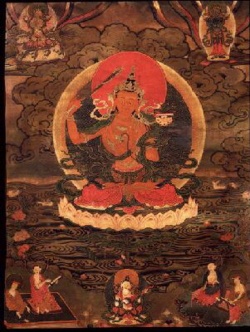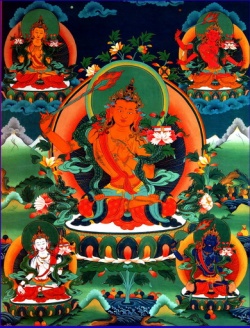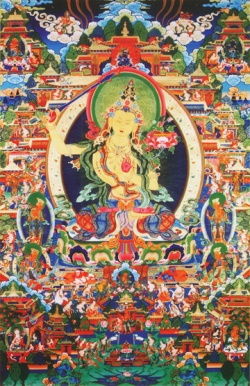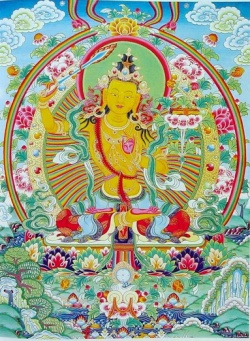Arya Manjushri Tantra Chitta—commentary
Quintessence of the Arya Mañjushri Tantra - Commentary
This quintessence of the tantra of the Great Perfection ofMañjushri has three parts.
1. The Meaning of the Beginning
In the language of India: ārya mañjushri tantra garbha
Since India is the source of the Dharma, this shows the pure origin of the teaching.
In the language of Tibet: ཕགས་པ་འཇམ་དཔལ་རྒྱུད་ཀྱི་ཡང་སྙིང། (pakpa jampal gyü kyi yang nying)
It is translated in order to make it it is easier to understand.
Homage is then paid to the yidam deity, so that obstacles will not arise, and merit will increase:
Homage to Mañjushri!
Mañjushri is Gentle Glory: ‘gentle’ indicates the freedom from the two obscurations, which is the perfect abandonment; ‘glory’ indicates the perfect realization, in which all qualities are fully present.
What does this refer to? It is the wisdom of the natural state of the Great Perfection, which is by its nature clear light with the essence of emptiness.
To realize this without duality is to pay homage.
2. The Meaning of the Main Part
From this point onwards is the main part of the text. First of all, there is the perfect context for the teaching, which is shown by the words ‘in this way’.
This indicates the five perfections. It indicates that in this place, this teacher gave this teaching, at this time, to this retinue.
The place is the great heaven of Akanishtha, the teacher is the Buddha Vajradhara, the teaching is this tantra, which reveals the profound nature of ultimate reality, the retinue is made up of bodhisattvas on the tenth bhumi, such as Vajrapani and the rest, and the time is the inconceivable time.
Furthermore, this same phrase also shows how the teaching was brought about: as a result of Vajrapani’s request to reveal the profound and secret teaching, the teacher taught in this way. At that time, the teacher and retinue were blessed into a state of indivisibility.
Then the actual theme of the tantra is expressed in terms of the three tantras (or continua)—the continua of the ground, path and fruition.
The Continuum of the Fruition
The continuum of the fruition is taught first in order to inspire students.
‘The Awakened One, the transcendent Lord’ indicates the ultimate level of fruition, the state of a perfectly awakened buddha or transcendent lord, who has abandoned all that must be abandoned, realized all that must be realized, and carries out enlightened activity continually and uninterruptedly.
The Continuum of the Ground
Then the continuum of the ground is shown.
You might wonder from where the continuum of the fruition arises, so the text says, ‘The wisdom kaya, spontaneously arisen.
’ Wisdom here means the apparent wisdom, which is pure awareness, or rigpa.
Kaya means the dharmakaya, the aspect of emptiness.
This emptiness and clarity, which has the essence of awareness, is the nature of all beings’ minds.
It is not made any better by enlightenment;
nor does the state of an ordinary being make it any worse. It has always been present, without falling into the extremes of samsara or nirvana, and so it is naturally arisen.
The Continuum of the Path
Although this naturally arising wisdom already abides in such a way, the continuum of the path must still be revealed so that we can purify our false clinging and dualistic perception.
‘The single eye of wisdom, entirely unobscured’ refers therefore to the essence, the wisdom of primordial purity, which is free from all delusion.
This is referred to as the ‘eye’ of wisdom because it is our own individual awareness.
It is ‘single’ because this alone sees the nature of all things. It is ‘entirely unobscured’ because when we rest in this pure awareness according to its own mode of being, all the conceptual constructs of dualistic perception are pacified.
The next line, ‘the light of wisdom, forever shining brightly’, refers to the nature, the wisdom of spontaneous presence, which is referred to as the light of wisdom because it has the discernment of clear light.
When this is seen through skilful means it continually arises, so the text says ‘forever shining brightly.’
As the mind becomes habituated to these two forms of wisdom, all our dualistic perceptions and the elements of the body are all purified, and we attain the kaya of the wisdom being Mañjushri, so the texts says ‘To you, Arapachana,
I pay homage.’ This refers to the wisdom of clear light, which is beyond arising, beyond ceasing, beyond remaining, beyond characteristics, beyond aspiration, and beyond coming and going.
This is the meaning of the main part: realizing the ground, training in the path and gaining the fruition.
3. The Meaning of the Conclusion
Then there is a praise rejoicing in the meaning of what has been expressed: ‘To you, the very embodiment of wisdom, I bow.’ This is a homage paid in the recognition and realization that the teacher and retinue are non-dual in nature.
‘Thus it is explained by all the perfect buddhas’ means that since this is the profound definitive meaning which is taught by all the buddhas of the past, present and future, it should be cherished by all those of supremely good merit and fortune.
The main part of the text could also be explained in another way. The first wisdom could be taken to mean the yoga of the Great Perfection beyond conceptual ideas, and the second wisdom could refer to the deity, mantra, mandala, subtle channels, energies and essences and so on.
The name of the tantra is the ‘Essence of the Perfect Recitation of the Names of the Wisdom Being, the Transcendent Lord Mañjushri’.
‘Essence’ here indicates that just like butter churned from milk, the entire meaning of the tantra is shown here in just three statements.
This concludes this teaching, spoken by the transcendent lord Shakyamuni.
Of the two categories—Word and treatises—this belongs to the category of Buddha Word.
Of the three types of Buddha Word—directly spoken, spoken by authorization and spoken through blessing—this belongs to the category of teachings that were directly spoken.
As for the one who taught it, it was Shakyamuni.
He taught it directly, and since all buddhas are one in their wisdom mind, they also taught it indirectly.
‘This concludes’ means that this is complete in terms of both word and meaning, with nothing whatsoever omitted.
Guru Padma gave this to Jomo Shedrön.
Then it was hidden as a terma.
The precious Guru Chökyi Wangchuk took it from Khoting Lhakhang in Lhodrak, where it was entrusted to Nyentön Dzambhala of Yangdrok and the terma seals were released, bringing benefit to beings on a vast scale.
Virtue! Virtue! Virtue!
| Translated by Adam Pearcey, Rigpa Translations, 2007.
ཤེས་བཟང་སྒྲོན། (shé zang drön), a consort of Guru Rinpoche. She later incarnated as Tertön Sarben (or Bensar) Chokme. ↩
Nyentön Dzambhala was one of the main terma assistants (teryok) of Guru Chöwang. ↩



